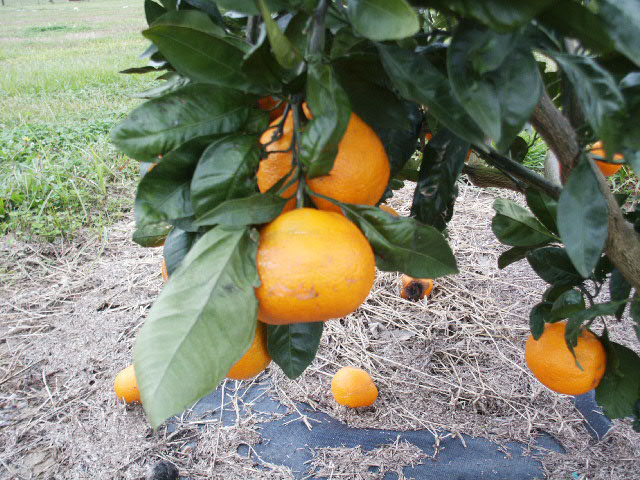By Katie Jackson
 As the heat of August settles fully upon us, there’s nothing like taking a break from our gardening chores under the shade of a spreading tree. Yet these generous giants of the landscape give us so much more than shade.
As the heat of August settles fully upon us, there’s nothing like taking a break from our gardening chores under the shade of a spreading tree. Yet these generous giants of the landscape give us so much more than shade.
They clean the air, turn carbon dioxide into oxygen, help stabilize soil and reduce water pollution, provide aesthetic beauty to the landscape, increase the value of real estate, provide habitat and sustenance for wildlife, give us branches for climbing and building tree houses and, of course, provide us with wood, paper and other products.
In addition to all those benefits, trees also provide us with a wide array of fruits and nuts that, in turn, give us a chance for an almost year-round supply of something delicious and nutritious to eat.
In the spring and early summer, plums and nectarines are in abundance. As summer progresses, peaches (the official state fruit of Alabama) come into their own, followed by figs and, as early as this month, even apples. More and more apple varieties will be available this fall as well as persimmons and pears. Later in the fall and into early winter, pecans, walnuts and chestnuts will be raining down, and a variety of citrus fruits will be ready to pluck—all just in time for the holidays. In short, we can have something Alabama-grown and delicious regardless of the season if we just take advantage of the bounty of our trees.
Of course an ideal way to have access to all this bounty is to establish home plantings of fruit and nut trees. While late fall, winter and very early spring are the best times to plant most trees, as well as many fruiting vines and bushes, there is no time like the present—maybe as you sit in the shade of a tree this summer—to start considering what and where to plant a few trees or even a small orchard for yourself.
A great resource for home gardeners is the Alabama Cooperative Extension System publication Fruit Culture in Alabama (www.aces.edu/pubs/docs/A/ANR-0053-A/index2.tmpl), which offers details on how to choose fruit types and varieties, select and prepare a site for planting and care for your trees throughout the year. Similar publications are available for pecans and other nuts, berries, grapes, kiwifruit and even some more novel tree, bush and vine crops. To learn more, search the ACES website at www.aces.edu for “home fruit and nut production” or ask your local Extension office for help.
Planting fruit and nut trees is also something of a social movement. Think Johnny Appleseed on a bigger and more diverse scale. Many horticultural experts these days recommend the inclusion of fruit and nut trees as part of a beautiful and edible landscape. Other groups advocate planting fruit trees as a community-building project. For example, the nonprofit Fruit Tree Planting Foundation (www.ftpf.org) has a goal of planting 18 billion fruit trees (approximately three for every person alive) worldwide. Communities can apply to them for assistance, including donations of trees and help with planting and caring for those trees. And, for a $50 tax-deductible donation, they also offer the Home Orchard Handbook: A Complete Guide to Growing Your Own Fruit Trees Anywhere, which helps homeowners create and sustain their own orchards.
Don’t have the space or inclination to plant fruit and nut trees? No problem. Alabama is chock full of commercial orchards, berry farms and vineyards that offer the bounty of their boughs and branches to the public, many of which also offer value-added products such as jams, jellies and baked goods as well as family-friendly on-farm activities and events.
To find such an experience or sources of fresh fruits, nuts and other Alabama grown and made products in your part of the state visit the Pick Your Own website at www.pickyourown.org/AL.htm, the Local Harvest website at www.localharvest.org, the Alabama Fruit and Vegetable Growers Association website at www.aces.edu/department/associations/afvga/ or, to find out about farms that offer tours and other special events throughout the year, check out the Alabama Agri-tourism website at www.alabamaagritourism.com.
August tips:
*Watch for signs of insect and disease damage on ornamental and vegetable plants and treat for problems before they get out of hand.
*Continue to mow and water lawns as needed. Keep container plants well watered, too.
*Divide irises and other perennials that have become overcrowded.
*Plant fall vegetables such as cabbage, collards and broccoli, and fall-bearing beans and peas.
*Plant a winter cover crop in your garden as it finishes its growing season.
*Keep fresh water in birdbaths.
*Plant seeds of cool-season flowers such as snapdragons, dianthus and pansies in flats or in the garden for fall blooms.
*Order fall-planted bulbs and start looking in catalogues and online for sources of fall-planted trees, shrubs and trees to order later.
*Use mosquito repellant and sunscreen when you’re out in the yard or garden.




